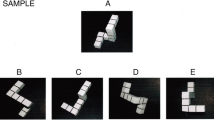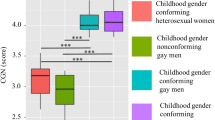Abstract
Within the Extreme Male Brain theory, Autism Spectrum Disorder is characterised as a deficit in empathising in conjunction with preserved or enhanced systemising. A male advantage in systemising is argued to underpin the traditional male advantage in mental rotation tasks. Mental rotation tasks can be separated into rotational and non-rotational components, and circulating testosterone has been found to consistently relate to the latter component. Systemising was found to correlate with mental rotation, specifically the non-rotational component(s) of the mental rotation task but not the rotational component of the task. Systemising also correlated with a proxy for circulating testosterone but not a proxy for prenatal testosterone. A sex difference was identified in systemising and the non-rotational aspect of the mental rotation task.
Similar content being viewed by others
References
Alexander, G. M., & Son, T. (2007). Androgens and eye movements in women and men during a test of mental rotation ability. Hormones and Behavior, 52, 197–204.
Auyeung, B., Baron-Cohen, S., Chapman, E., Knickmeyer, R., Taylor, K., & Hackett, G. (2006). Foetal testosterone and the child systemizing quotient (SQ-C). European Journal of Endocrinology, 155, 123–130.
Axelsson, J., Ingre, M., Åkerstedt, T., & Holmbäck, U. (2008). Effects of acutely displaced Sleep on testosterone. The Journal of Clinical Endocrinology & Metabolism, 90, 4530–4535.
Baron-Cohen, S. (2002). The extreme male brain theory of autism. Trends in Cognitive Science, 6, 248–254.
Baron-Cohen, S. (2003). The essential sex difference. London: Allen Lane.
Baron-Cohen, S. (2006). Two new theories of autism: Hyper-systemising and assortative mating. Archives of Disease in Childhood, 91, 2–5.
Baron-Cohen, S. (2008). Autism, hypersystemizing, and truth. Quarterly Journal of Experimental Psychology, 61, 64–76.
Baron-Cohen, S., Knickmeyer, R. C., & Belmonte, M. K. (2005). Sex differences in the brain: Implications for explaining autism. Science, 310, 819–823.
Baron-Cohen, S., Wheelwright, S., Scahill, V., Lawson, J., & Spong, A. (2001). Are intuitive physics and intuitive psychology independent? A test with children with Asperger Syndrome. Journal of Developmental and Learning Disorders, 5, 47–78.
Brosnan, M. (2006). Digit ratio and faculty membership: Implications for the relationship between prenatal testosterone and academic ability. British Journal of Psychology, 97, 455–466.
Brosnan, M., Walker, I. & Collomosse, J. (2009). The effect of explicitly varying the proportion of ‘Same’ and ‘Different’ responses on sex differences in the Shepard and Metzler mental rotation task. European Journal of Cognitive Psychology.
Butler, T., Pan, H., Imperato-McGinley, J., Voyer, D., Cunningham-Bussel, A. C., Cordero, J. J., et al. (2007). A network approach to fMRI condition-dependent cognitive activation studies as applied to understanding sex differences. Clinical Neuroscience Research, 6, 391–398.
Cohen-Bendahan, C. C. C., van de Beek, C., & Berenbaum, S. A. (2005). Prenatal sex hormone effects on child and adult sex-typed behavior: Methods and findings. Neuroscience and Biobehavioral Reviews, 29, 353–384.
Collins, D. W., & Kimura, D. (1997). A large sex difference on a two-dimensional mental rotation task. Behavioral Neuroscience, 111, 845–849.
Dabbs, J. M. (1990). Salivary testosterone measurements: Reliability across hours, days and weeks. Physiology & Behavior, 48, 83–86.
Diver, M. J., Imtiaz, K. E., Ahmad, A. M., Vora, J. P., & Fraser, W. D. (2003). Diurnal rhythms of serum total, free and bioavailable testosterone and of SHBG in middle-aged men compared with those in young men. Clinical Endocrinology, 58, 710–717.
Falter, C. M., Arroyo, M., & Davis, G. J. (2006). Testosterone: Activation or organization of spatial cognition? Biological Psychology, 73, 132–140.
Falter, C. M., Plaisted, K. C., & Davis, G. (2008a). Visuo-spatial processing in autism—Testing the predictions of extreme male brain theory. Journal of Autism and Developmental Disorders, 38, 507–515.
Falter, C. M., Plaisted, K. C., & Davis, G. (2008b). Male brains, androgen, and the cognitive profile in autism: Convergent evidence from 2D:4D and congenital adrenal hyperplasia. Journal of Autism and Developmental Disorders, 38, 997–998.
Gill, H. S., O’Boyle, M. W., & Hathaway, J. (1998). Cortical distribution of EEG activity for component processes during mental rotation. Cortex, 34, 707–718.
Grimshaw, G. M., Sitarenios, G., & Finegan, J. K. (1995). Mental rotation at 7 years: Relations with prenatal testosterone levels and spatial play experiences. Brain and Cognition, 29, 85–100.
Halari, R., Hines, M., Kumari, V., Mehrotra, R., Wheeler, M., Ng, V., et al. (2005). Sex differences and individual differences in cognitive performance and their relationship to endogenous gonadal hormones and gonadotropins. Behavioral Neuroscience, 119(1), 104–117.
Hines, M. (2004). Brain gender. Oxford: Oxford University Press.
Hooven, C. K., Chabris, C. F., Ellison, P. T., & Kosslyn, S. M. (2004). The relationship of male testosterone to components of mental rotation. Neuropsychologia, 42, 782–790.
Hugdahl, K., Thomsen, T., & Ersland, L. (2006). Sex differences in visuo-spatial processing an fMRI study of mental rotation. Neuropsychologia, 44, 1575–1583.
Hulmi, J. J., Ahtiainen, J. P., Selanne, H., Volek, J. S., Hakkinen, K., Kovanen, V., et al. (2008). Androgen receptors and testosterone in men—Effects of protein ingestion, resistance exercise and fiber type. The Journal of Steroid Biochemistry and Molecular Biology, 110, 130–137.
Johnson, E. S., & Meade, A. C. (1987). Development patterns of spatial ability: An early sex difference. Child Development, 58, 725–740.
Jolicoeur, P., Regehr, S., Smith, L. B. J. P., & Smith, G. N. (1985). Mental rotation of representations of two-dimensional and three-dimensional objects. Canadian Journal of Psychology, 39, 100–129.
Jordan, K., Wüstenberg, T., Heinze, H. J., Peters, M., & Jäncke, L. (2002). Women and men exhibit different cortical activation patterns during mental rotation tasks. Neuropsychologia, 40, 2397–2408.
Karadi, K., Kallai, J., & Kovacs, B. (2001). Cognitive subprocesses of mental rotation: Why is a good rotator better than a poor one? Perceptual Motor Skills, 93, 333–337.
Kerkman, D. D., Wise, J. C., & Harwood, E. A. (2000). Impossible ‘mental rotation’ problems—A mismeasure of women’s spatial abilities? Learning and Individual Differences, 12, 253–269.
Knickmeyer, R. C., Baron-Cohen, S., Auyeung, B., & Ashwin, E. (2008). How to test the extreme male brain theory of autism in terms of foetal androgens? Journal of Autism and Developmental Disorders, 38, 995–996.
Linn, M. C., & Petersen, A. C. (1985). Emergence and characterization of sex differences in spatial ability: A meta-analysis. Child Development, 56, 1479–1498.
Lutchmaya, S., Baron-Cohen, S., Raggatt, P., Knickmeyer, R., & Manning, J. T. (2004). 2nd to 4th digit ratios, fetal testosterone and estradiol. Early Human Development, 77, 23–28.
Manning, J. T., Baron-Cohen, S., Wheelwright, S., & Sanders, G. (2001). The 2nd to 4th digit ratio and autism. Developmental Medicine and Child Neurology, 43, 160–164.
Manning, J. T., Bundred, P. E., Newton, D. J., & Flanagan, B. F. (2003). The second to fourth digit ratio and variation in the androgen receptor gene. Evolution and Human Behavior, 24, 399–405.
Manning, J. T., Fink, B., Neave, N., & Caswell, N. (2005). Photocopies yield lower digit ratios (2D:4D) than direct finger measurements. Archives of Sexual Behavior, 34, 329–333.
Manning, J. T., Scutt, D., Wilson, J., & Lewis-Jones, D. I. (1998). The ratio of 2nd to 4rth digit length: A predictor of sperm numbers, levels of testosterone, LH, oestrogen. Human Reproduction, 13, 3000–3004.
Matchock, R., Dorn, L., & Susman, E. (2007). Diurnal and seasonal cortisol, testosterone, and DHEA rhythms in boys and girls during puberty. Chronobiology International, 24, 969–990.
McIntyre, M. H. (2006). The use of digit ratio as markers for perinatal androgen action. Reproductive Biology and Endocrinology, 4(10). (February 26).
Moffat, S. D., & Hampson, E. (1996). Salivary testosterone levels in left- and right-handed adults. Neuropsychologia, 34, 225–233.
Peters, M. (2005). Sex differences and the factor of time in solving Vanderberg and Kuse mental rotation problems. Brain and Cognition, 57, 176–184.
Peters, M., Manning, J. T., & Reimers, S. (2007). The effects of sex, sexual orientation, and digit ratio (2D:4D) on mental rotation performance. Archives of Sexual Behavior, 36, 251–260.
Phillips, R. (1979). Phillips S & M test. Windsor, Berks: NFER-NELSON.
Sanders, G., Bereczkei, T., Csatho, A., & Manning, J. (2005). The ratio of the 2nd to 4th finger length predicts spatial ability in men but not women. Cortex, 41, 789–795.
Schoning, S., Engelien, A., Kugel, H., Schafer, S., Schiffbauer, H., Zwitserlood, P., et al. (2007). Functional anatomy of visuo-spatial working memory during mental rotation is influenced by sex, menstrual cycle, and sex steroid hormones. Neuropsychologia, 45, 3203–3214.
Shepard, R. N., & Cooper, L. A. (1982). Mental images and their transformations. Cambridge, MA: MIT Press.
Shepard, R. N., & Metzler, J. (1971). Mental rotation of three-dimensional objects. Science, 171, 701–703.
Silk, T. J., Rinehart, N., Bradshaw, J. L., Tonge, B., Egan, G., O’Boyle, M. W., et al. (2006). Visuospatial processing and the function of prefrontal-parietal networks in autism spectrum disorders: A functional MRI study. American Journal of Psychiatry, 163, 1440–1443.
Silverman, I., Philips, K., & Silverman, L. K. (1996). Homogeneity of effect sizes for sex across spatial tests and cultures: Implications for hormonal therapies. Brain and Cognition, 31, 90–94.
Solomon, M., Ozonoff, S. J., Cummings, N., & Carter, C. S. (2008). Cognitive control in autism spectrum disorders. International Journal of Developmental Neuroscience, 26, 239–247.
Thomsen, T., Hugdahl, K., Ersland, L., Barndon, R., Lundervold, A., Smievoll, A. I., et al. (2000). Functional magnetic resonance imaging (fMRI) study of sex differences in a mental rotation task. Medical Science Monitor, 6, 1186–1196.
Valdez, P., Reilly, T., & Waterhouse, J. (2008). Rhythms of mental performance. Mind, Brain, and Education, 2, 7–16.
von Horn, A., Bäckman, L., Davidsson, T. & Hansen, S. (2009). Empathizing, systemizing and finger length ratio in a Swedish sample. Scandinavian Journal of Psychology.
Voracek, M., & Dressler, S. G. (2006). Lack of correlation between digit ratio (2D:4D) and Baron-Cohen’s ‘‘Reading the Mind in the Eyes’’ test, empathy, systemising, and autism-spectrum quotients in a general population sample. Personality and Individual Differences, 41, 1481–1491.
Voyer, D., Butler, T., Cordero, J., Brake, B., Silbersweig, D., Stern, E., et al. (2006). The Relation between computerized and paper-and-pencil mental rotation tasks: A validation study. Journal of Clinical and Experimental Neuropsychology, 28, 928–939.
Voyer, D., & Hou, J. (2006). Type of items and the magnitude of gender differences on the mental rotations test. Canadian Journal of Experimental Psychology, 60, 91–100.
Voyer, D., Voyer, S., & Bryden, M. (1995). Magnitude of sex differences in spatial abilities: A meta-analysis and consideration of critical variables. Psychological Bulletin, 2, 250–270.
Author information
Authors and Affiliations
Corresponding author
Rights and permissions
About this article
Cite this article
Brosnan, M., Daggar, R. & Collomosse, J. The Relationship Between Systemising and Mental Rotation and the Implications for the Extreme Male Brain Theory of Autism. J Autism Dev Disord 40, 1–7 (2010). https://doi.org/10.1007/s10803-009-0815-3
Received:
Accepted:
Published:
Issue Date:
DOI: https://doi.org/10.1007/s10803-009-0815-3




